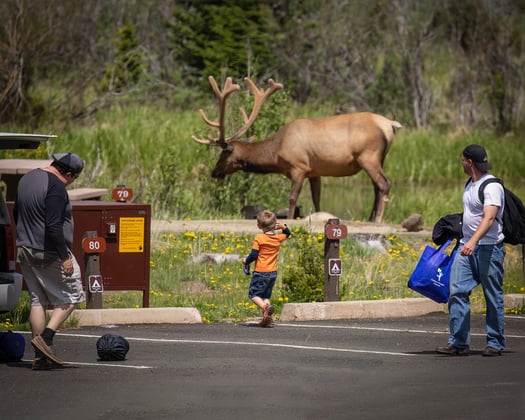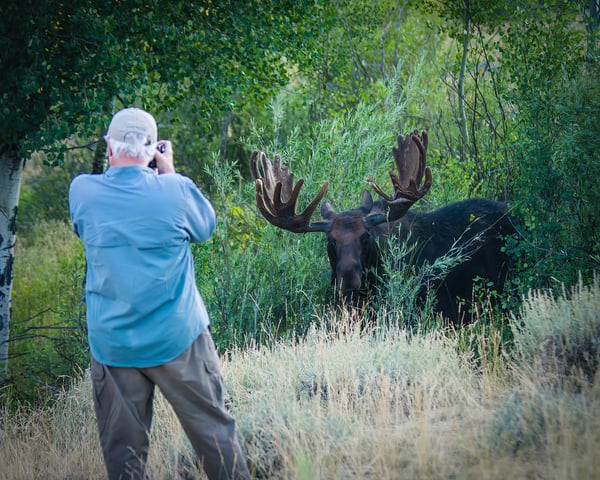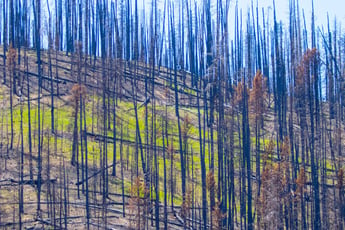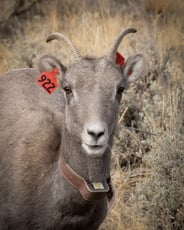By Kathryn Middleton
Photos by Rick Spitzer
For the Eagle County Community Wildlife Roundtable
Did you receive the Eagle County alert message via Everbridge a few weeks back that alerted the public that a mule deer doe was protecting her fawn and that we should stay away and give ‘em space?
We are fortunate to live with an abundance of wildlife in Eagle County so that alert was a good reminder to us that wildlife lives near us, and we need to act responsibly. The parents of these young animals are prepared by nature to survive in the wild without human intervention and will be very protective if we get too close. Colorado Parks & Wildlife (CPW) reports that in most cases, human intervention does more harm than good, so please give ‘em space!
A really, really bad idea.
Recreating near wildlife is a privilege. The impact we have on wildlife is magnified by dogs, horses, mountain bikes and mechanized uses. Keep your distance and do not touch wildlife. Human interaction is not natural and is a threat to their survival. As always, that means keeping dogs on leashes and at a distance when wildlife is present to avoid triggering aggressive behavior. Elk and moose will chase dogs back to their owners creating a dangerous situation for all.
Humans impact all forms of wildlife, but mule deer, elk and moose are three species humans encounter most often in Eagle County. Their behavior, physiology, and energy are affected by the presence of humans in the wilderness. When dogs are present, wildlife associate them as a natural predator so their instinct to protect themselves is heightened, especially when the females are protecting their young.
Continued human encounters with wildlife create behavioral changes, some species may avoid areas where they typically migrate, breed, or calve. When wildlife encounter humans their stress levels rise as well, impacting their immunity to disease. If extra energy is used to avoid humans, it may result in the loss of body fat from running away, that in turn, reduces time for wildlife to forage. The mere presence of humans creates negative responses which impacts mule deer, elk and moose species’ population fitness, growth, and overall population sizes potentially leading to functional extirpation from some of their historic habitats and ecoregions.
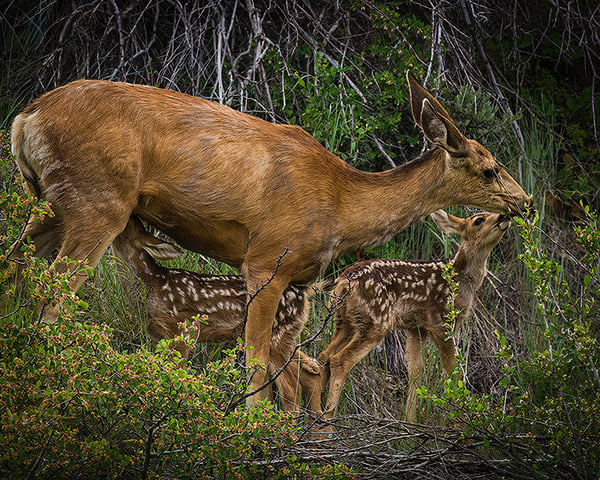
If you flush some young animals, they may not be reunited with their mother.
Newborn mule deer fawns are born in late spring and early summer. It is common for does to leave their fawns alone during the day for their first few weeks of life to hide them from predators while mothers eat and rest. Mule deer fawns are born with soft brown coats dotted with white spots along their sides and backs to help camouflage them in their surroundings. It may also be interesting to learn that they are born without a scent so predators cannot smell them. The mothers will check in with their offspring during the day to nurse and care for them but will leave them alone for periods of time the first few weeks until the fawn is strong enough to accompany their mothers.
Elk calves and cows exhibit similar behavior to mule deer. Elk cows will move away from their calves during the day but will remain close by to protect their young from predators for the first few weeks of the calves’ lives. Like mule deer, newborn elk claves are camouflaged by small white spots on their soft brown coats, they also do not have a scent that predators can detect.
You may encounter female elk with their calves in large nursery bands in aspen forests and meadows near water drainages where they rest and graze. These nursery bands can occur in numbers of more than one-hundred individuals. Elk generally avoid humans but can become aggressive when protecting their calves. If an elk becomes annoyed or aggressive, they will hold their heads high, lay their ears back and flare their nostrils, you may even see them stomp their front hooves. Stay away but keep calm. Enjoy and observe from afar, our scent can remain behind if you get too close to the babies so, please don’t approach them.
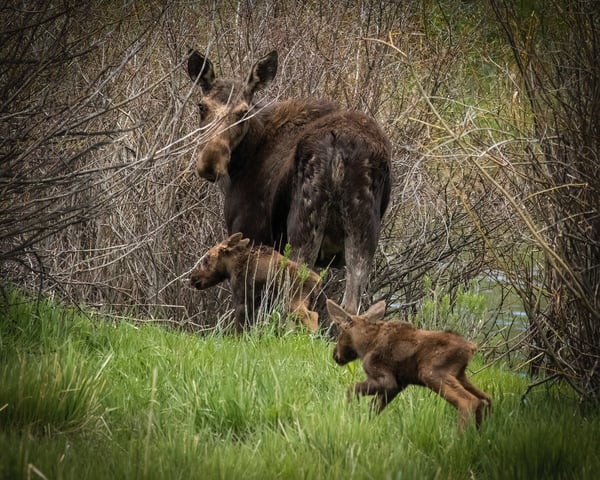
A moose will defend its calves at all expense. Don’t take the chance.
Moose are also active in Eagle County. Thanks to Colorado Parks & Wildlife’s reintroduction efforts in 1978, moose populations in Colorado are thriving. Moose populations have successfully been established and have spread across the Colorado landscape and are now common in many areas in Eagle County.
We are lucky to be able to observe these magnificent animals in our backyard, but keep in mind that dogs and moose are not a good combination! Stay away, remember that moose see dogs as a predator. If you see a moose with her young keep your distance, she will aggressively attack if you get too close. Moose will charge if they are threatened. If that instance arises do as CPW advises - run and put an object like a tree between you and the moose.
Moose cows give birth in May and June. They prefer thick willowy habitat near riparian areas that provide cover for their claves and space for mothers to graze and rest during the day. It is not uncommon for a moose cow to give birth to twins; even a few triplets have been documented! Moose often go unnoticed by humans as they spend most of their day in heavy, dark forested areas near riparian zones along streams, riverbanks, and lakes in Eagle County. Keep an eye out for them but don’t try to get near them, they are big and powerful and can be dangerous to humans.
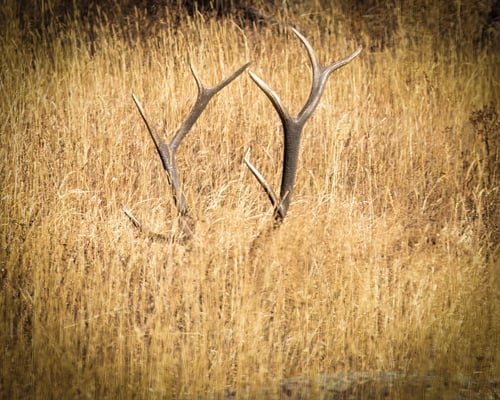
When out hiking, pay attention to your surroundings. Wildlife may not be as obvious as you think they are.
If you happen to encounter mule deer fawns, elk or moose calves that appear to be alone remember these 4 things.
1) Don’t approach them and take a picture from a distance. Believe that it is very unlikely that any newborns have been abandoned,
2) Don’t touch or pet, or try to feed them, your scent will remain on the animal leaving them vulnerable to predators,
3) Give them plenty of space, if you scare them, they may move from their hiding place and their mothers may not be able to find them,
4) NEVER attempt to remove them from their hiding place or from anywhere in the wild. This can have fatal consequences. If you sense something is wrong, report it to the nearest Colorado Parks & Wildlife office.
Colorado Parks & Wildlife reminds us that “by allowing our wildlife to retain their natural, healthy wild instincts, we show our respect for their wild lives”.
This information and much more is all available at Colorado Parks & Wildlife’s website at cpw.state.co.us/learn/Pages/LivingwithWildlifeSpring.aspx. All the information I researched and used for this article is available at your local county and state parks and wildlife service office and websites.
Kathryn Middleton has lived in Vail since 1982, she is a member of the Eagle County Wildlife Roundtable and participates in the Education/Outreach Committee. She also serves on the board for the Mountain Valley Horse Rescue in McCoy, Colorado.
======================================
The Eagle County Community Wildlife Roundtable is a collaborative partnership with the White River National Forest, Colorado Parks and Wildlife, Bureau of Land Management, local government entities, community members, and citizen scientists. The purpose of the Eagle County Community Wildlife Roundtable is to gather a group of diverse stakeholders in the valley to understand and address issues facing wildlife populations. Together we will identify a shared vision and realistic actions that the community can rally around to support wildlife. We want to leverage diverse values, creativity, and resources to move toward positive action.
======================================
